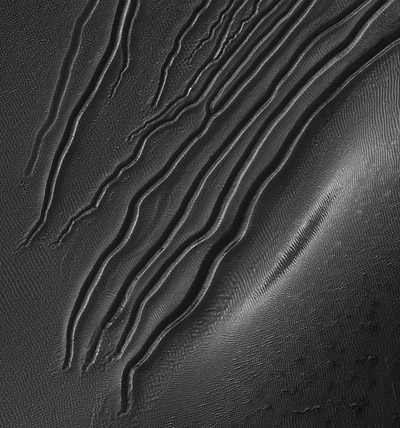
This is the fun of using photographic surveys of other bodies in the solar system. Often planetary geologists have just one photo, from one angle and one lighting condition, to try and puzzle out what kind of feature they’re seeing. It’s not something that comes up often, since us laypeople generally see images of very familiar things, but the two-dimensional trait of photography can produce lots of peculiar impressions. We can’t shift slightly to the side to see how the shadows or perspective changes, we can’t use the inherent depth perception of our two eyes, and we can’t even be sure we’re seeing a real shadow or simply an area of darker material. A gully or a ridge can look exactly the same with the light coming from opposite directions, so often it’s not just a single feature that needs to be examined, but all of the conditions surrounding it.
I’m not going to even imply that I have anywhere near the abilities of those who evaluate geological images professionally, but I have done a fair share of photographic examinations, sometimes to detect hoaxes, but also just to tease out illusions. It helps to know that, for any given shape, texture, or geology, light direction tells us how oblique a surface is to the angle of light. In other words, if we imagine ourselves traveling in the same direction as the light falling onto a shape, whatever turns “uphill” to us will become brighter and more reflective, and what turns “downhill” will become dark, maybe even fall completely into shadows since it’s “out of sight” over the ridge. So, I had stared at the sample photo for a while before posting (at that time, under the nym “Just Al”):
I don’t know – looking at the first image under higher res and additional magnification, I suspect something else entirely is at work here.
Look at the shadows of the central large furrow, and most especially to the right of it. Unless I’m misinterpreting them, that furrow is actually running a ridge line, and while it turns downslope slightly (lower right) it then turns away. That somehow doesn’t seem right.
The other thing that seems counterintuitive is that the furrows, nearly all of them, show pushed-up edges on both sides. This might simply be an artifact of crosswind sand deposits, but it doesn’t seem likely that this would occur on both sides. Fluids digging furrows don’t typically push up deposits on both sides unless they’re moving pretty fast, and then they display turns with greater washouts and “elbows.” They also seem unlikely to peter out so abruptly without either fanning or “pointing.”
The lack of points also seems to rule out some kind of erosion “slipping,” the crust cracking and splitting towards the downslope side – the ends shouldn’t look like that.
Then there’s the idea that when the forks come together, the channels don’t widen, seeming to indicate that the channels were carved singly at different times.
Now, here’s what’s occurring to me right now: is there such a thing as a CO2 glacier? Because this seems to fit the furrows closer than anything else I’ve thought of so far, and the cohesiveness of a glacial body might prevent sideslipping a bit. Not a perfect idea, I admit, but the best I’ve come up with so far…
I don’t maintain regular access to planetary and astronomical studies anymore, and so wasn’t following any new developments in this area, but today’s Astronomy Picture of the Day was a nice little vindication.

A leading hypothesis — actually being tested here on Earth — is that these linear gullies are caused by chunks of carbon dioxide ice (dry ice) breaking off and sliding down hills while sublimating into gas, eventually completely evaporating into thin air.
(Where the hell did the idea of huffing on your nails and polishing them on your shirt come to indicate smugness? Regardless, I’m doing that like an annoying bastard right now.)
None of this is proven yet, of course, and won’t be until we find an actual chunk of solid CO2 plowing its way along the Martian landscape. In the meantime, I’ll be happy to offer my services to the Jet Propulsion Laboratory – for a hefty fee, I think it goes without saying…



















































